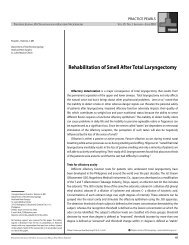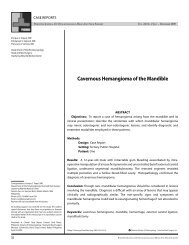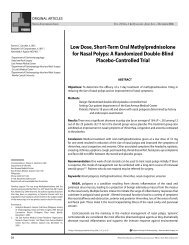You also want an ePaper? Increase the reach of your titles
YUMPU automatically turns print PDFs into web optimized ePapers that Google loves.
On her 1st admission (July, 1989), findings showed following: (1) serial serum calcium determination was<br />
3 cm. fixed, hard and nontender mass on the left persistently elevated (3.27, 3.06, 3.12); (2) serum<br />
maxillary area. Excision biopsy via Caldwell-Luc phosphate waslow at0.761 mmolXl (normal value=0.8-<br />
approach was done and histopathologic diagnosis was 1.6 mmolXl); (3) skeletal survey revealed a general-<br />
Giant Cell Granuloma. She was discharged asymp- ized skeletal demineralization, granular localization<br />
tomatic only to be readmitted 2 months later because (salt and pepper appearance) of the skull and nephof<br />
a recurrent progressive growth over the same site. roclacinosis with the renal calculus (see Figure 1);<br />
(4) ultrasonography of the neck revealed a 1.7 x 1.2<br />
On her second admission (Sept., 1989), the patient x 0.9 era. hypoechoic mass in the inferior portion of<br />
presented a slightly firm, non tender 7 x 4 cm. left the right thyroid probably an enlarged parathyroid,<br />
maxillary mass which was encroaching on the leR thyroid gland essentially normal. All the other laboorbit<br />
causing diplopia on downward gaze. The left ratory examinations (FBS, BUNXCrea, Na, K, CI, urine<br />
gingivobuccal gutter was obliterated anteriorly. No calcium, creatine clearance) were normal.<br />
paresthesia were noted. Routine laboratory examinations<br />
(urinalysis, CBC, BUNXCreatinine, serum Na, The patient underwent neck exploration flow-collar<br />
K, CI, Chest PA) for pre-operative clearance were incision) which revealed a 2 x 1.5 x 1 cm. firm solid<br />
unremarkable..Waters and Basal views revealed an mass under the right inferior thyroid vessels. The mass<br />
expansile soft tissue opacity in the left maxillary area was removed and frozen section was read as Paraextending<br />
upward to the inferior aspect of the orbit thyroid Adenoma. The right superior parathyroid and<br />
laterally, mucoperiosteal thickening was noted in the the two left parathyroid glands were explored and<br />
right maxillary sinus, the inferior rim of the orbit and identified and were found to be normal in size and<br />
anterior aspect of the left zygomatic bone were not appearance. The maxillary mass was left untouched.<br />
delineated. She underwent a second operation (Weber-<br />
Ferguson incision with lip splitting) with the follow- The patient tolerated the procedure very well. The<br />
ing findings: the mass eroded the anterior and lateral post operative serum calcium level was low at 1.97<br />
maxillary walls, filled the maxillary antrum and mmolM, She manifested symptoms of hypocalcemia<br />
partially eroded the orbital floor. Frozen section of which was readily controlled with calcium supplethe<br />
mass was read as Giant Cell Tumor. The bed was ments. The final histopathology report was read as:<br />
then extensively cleaned of tumor. The patients post- Parathyroid tissue, in the absence of capsule in the<br />
operative course was uneventful. She was discharged section submitted, distinction between Parathyroid<br />
after 9 days. The final histopathologic report was Giant Adenoma and Hyperplasia must be clinically corre-<br />
Cell Tumor.<br />
lated. (See Figure 2). Review of slides of 2 previous<br />
operations was read as consistent with Brown Tumor<br />
Two months later, .the patient again noted swel- of Hyperparathyroidism. (See Figure 3).<br />
ling of the left maxillary area lateral to the previous<br />
site. By this time, she was lost to follow-up only to The patient was eventually discharged and subcome<br />
back with markedly enlarged maxillary mass. sequent follow-ups revealed a progressive decrease<br />
Differential diagnosis for Giant Cell Tumor were con- in the size of the maxillary mass with resolution of<br />
sidered. Subsequent work- ups revealed serum cal- diplopia. (See Figure 4).<br />
cium to be abnormally high at 3.27 mmolXl (normal<br />
value----=2.35-2.75 mmolM). She was then referred to<br />
the Endocrine section for parathyroid hormone level DISCUSSION<br />
which likewise turned out to be markedly elevated<br />
at 47.69 mg'_ml (normal value=0.4-1.4 tug'real). She Hyperparathyroidism is a disorder of the paratywas<br />
eventually admitted for the third time. roid glands characterized by the abnormal secretion<br />
of parathyroid hormone leading to hypercalcema. The<br />
On her present admission (April, 1989), physical incidence of primary hyperparathyroidism has been<br />
examination showed a 7 x 8 cm. firm, slightly tender, reported between 25 and 50 per 100,000 population<br />
ill-defined mass extending from left molar to the left per year. The highest incidence occurs in women in<br />
zygomatic area with persistence of diplopia on the fourth to sixth decade of life approaching 200<br />
downward gaze. The rest of the examination was cases per 100,000 population per year.<br />
essentially normal. Diagnostic studies showed the<br />
18
















